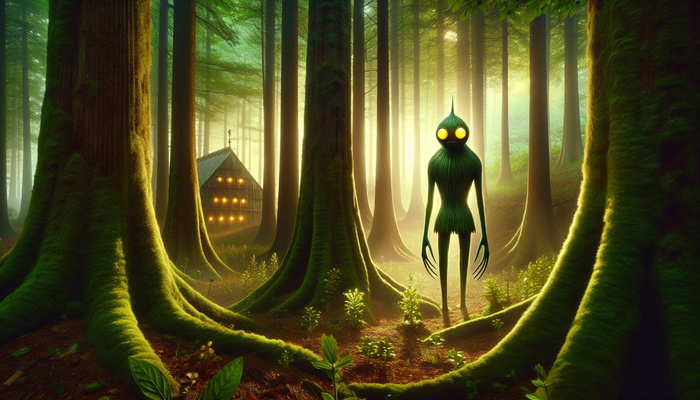The Almasty of the Caucasus Mountains

By Lucas Jennings, Cryptozoologist
As I sit here in my study, surrounded by maps of the Caucasus Mountains, blurry photographs of alleged Almasty sightings, and stacks of field notes from countless expeditions, I can't help but feel a sense of awe at the enduring mystery of the Almasty. This elusive creature, often referred to as the "wild man" of the Caucasus, has captivated the imagination of locals, researchers, and adventurers for centuries. As an expert in cryptozoology and a seasoned explorer of the world's most remote regions, I've dedicated a significant portion of my career to unraveling the enigma of the Almasty. In this comprehensive exploration, we'll delve deep into the myths, sightings, and scientific inquiries surrounding this fascinating cryptid, straddling the line between legend and potential reality.
The allure of the unknown has always been a powerful force in human nature. We're drawn to mysteries, to the possibility that there might be more to our world than what meets the eye. The Almasty embodies this allure perfectly, representing a tantalizing blend of folklore, eyewitness accounts, and scientific speculation. As we embark on this journey through the mist-shrouded peaks and dense forests of the Caucasus, we'll explore not just the physical evidence and historical accounts, but also the cultural significance of the Almasty and its impact on our understanding of the natural world.
Throughout my years of research, I've come to see the Almasty as more than just a potential undiscovered species. It's a symbol of the untamed wilderness, a reminder that even in our modern, hyper-connected world, there are still mysteries waiting to be unraveled. The Almasty challenges our assumptions about what we know and don't know, pushing the boundaries of scientific inquiry and forcing us to confront the limitations of our understanding.
In this article, we'll traverse the rugged terrain of the Caucasus Mountains, both literally and figuratively. We'll examine the origins and etymology of the Almasty, delve into eyewitness accounts spanning centuries, and scrutinize the latest scientific investigations into this enigmatic being. We'll also explore the cultural significance of the Almasty in local folklore and its parallels with other legendary creatures around the world.
As we embark on this exploration, I invite you to approach the subject with an open mind. The story of the Almasty is not just about the potential existence of an unknown hominid; it's about the human drive to explore, to question, and to seek understanding in the face of the unknown. Whether you're a skeptic or a believer, a scientist or a folklore enthusiast, there's something in the tale of the Almasty that speaks to our shared human experience.
So, let's begin our journey into the heart of the Caucasus, where ancient legends and modern science converge in the search for the elusive Almasty.
Origins and Etymology of the Almasty
The term "Almasty" rolls off the tongue with an air of mystery, evoking images of mist-shrouded mountains and shadowy figures lurking just beyond the firelight. But where does this intriguing name come from, and what can its origins tell us about the creature it describes?
The word "Almasty" is derived from the Mongolian term "Almas," which translates to "wild man." This linguistic connection is our first clue that the legend of the Almasty extends far beyond the Caucasus Mountains, tapping into a broader cultural narrative of wild, human-like beings that spans across Central Asia.
As I've delved deeper into the etymology of the Almasty, I've discovered a fascinating web of related terms across various languages and cultures. In the Caucasus region itself, you might hear the creature referred to as "Almasty," "Almasti," or even "Albasti." These variations reflect the diverse linguistic landscape of the area, where numerous languages and dialects intermingle.
Venturing further afield, we encounter other names that likely refer to the same or similar creatures. In Azerbaijan and Georgia, for instance, the term "Gul-bi-Aban" is sometimes used, which translates roughly to "desert demon." This name hints at the fear and reverence with which these beings are regarded in local folklore.
The linguistic diversity surrounding the Almasty is a testament to its widespread cultural significance. Each name carries with it a unique set of connotations and cultural baggage, reflecting the complex relationship between humans and the unknown in different societies.
One of the earliest written references to creatures resembling the Almasty comes from the 15th century, in the accounts of Hans Schiltberger, a German nobleman who found himself held captive by Mongol warriors. Schiltberger's writings describe encounters with "animal men," beings that walked on two legs but were covered in hair and possessed great strength. While we must approach historical accounts like these with a critical eye, they provide valuable insight into the long-standing nature of the Almasty legend.
Schiltberger's account is particularly intriguing because it places the Almasty (or a similar creature) in the context of a broader Central Asian tradition of wild men. This suggests that the concept of human-like beings living on the fringes of civilization is not unique to the Caucasus, but part of a larger cultural phenomenon that spans vast geographical areas.
As we trace the origins of the Almasty through language and historical accounts, we begin to see how deeply rooted this legend is in the cultural fabric of the region. The Almasty is not merely a creature of recent invention or a product of modern cryptozoology. Instead, it represents a long-standing tradition of stories and beliefs about the unknown that have been passed down through generations.
The etymology of the Almasty also provides clues about how these creatures are perceived by local populations. The term "wild man" suggests a being that is human-like in many respects, yet distinct from civilized society. This linguistic framing places the Almasty in a liminal space between the human and animal worlds, a theme we'll see repeated throughout various cultural interpretations of the creature.
It's worth noting that the concept of wild men or human-like creatures living in remote areas is not unique to Central Asia. Similar legends exist around the world, from the Yeti of the Himalayas to the Sasquatch of North America. This global distribution of similar myths raises intriguing questions about the origins of these stories. Are they all independent inventions, arising from similar human experiences and fears? Or do they point to a shared cultural memory of encounters with now-extinct hominid species?
As a researcher, I find the linguistic and historical roots of the Almasty fascinating not just for what they tell us about the creature itself, but for what they reveal about human culture and our relationship with the unknown. The persistence of the Almasty legend across centuries and diverse cultures speaks to a deep-seated human need to explain the unexplained, to give form to the formless shadows at the edges of our known world.
The etymology of the Almasty also highlights the importance of local knowledge and traditions in cryptozoological research. While scientific inquiry is crucial, we must not overlook the wealth of information contained in folklore and indigenous knowledge systems. These cultural narratives often contain valuable clues about the behavior, habitat, and characteristics of cryptids like the Almasty.
As we delve deeper into the world of the Almasty, keep in mind the rich linguistic and cultural tapestry from which this legend emerges. The name "Almasty" is more than just a label; it's a window into centuries of human experience, belief, and interaction with the unknown. It's a reminder that the search for cryptids like the Almasty is not just a scientific endeavor, but a journey into the heart of human culture and our enduring fascination with the mysteries that lurk just beyond our understanding.
Physical Description of the Almasty
As we venture deeper into the world of the Almasty, one of the most captivating aspects of this enigmatic creature is its physical appearance. Through countless eyewitness accounts, folklore descriptions, and even alleged footprint casts, a vivid picture of the Almasty has emerged over the years. However, it's crucial to approach these descriptions with a critical eye, understanding that they are often colored by cultural expectations, personal interpretations, and the inherent challenges of observing a creature that, if it exists, is notoriously elusive.
From the numerous reports I've studied and the interviews I've conducted with alleged eyewitnesses, a consistent image of the Almasty begins to take shape. Most accounts describe a bipedal creature, standing between five and six and a half feet tall. This height range is particularly interesting, as it places the Almasty in a similar size category to modern humans, yet often with a more robust build that sets it apart.
One of the most striking features consistently reported is the Almasty's covering of thick, shaggy hair. The color of this hair is often described as dark, ranging from a deep reddish-brown to black. This hirsute appearance is one of the key factors that lead many to draw parallels between the Almasty and other legendary creatures like Bigfoot or the Yeti. However, it's worth noting that unlike some depictions of these other cryptids, the Almasty's face is often described as more human-like, with less hair covering the facial features.
The facial characteristics of the Almasty are particularly intriguing from an anthropological perspective. Many accounts describe a pronounced brow ridge, reminiscent of early hominid species like Homo erectus or Neanderthals. This feature, combined with reports of a flattened nose and a somewhat receding chin, creates an image of a creature that seems to straddle the line between human and ape-like appearances.
One eyewitness account that stands out in my research comes from a Russian zoologist named Grigory Panchenko. In 1991, Panchenko claimed to have observed an Almasty from a hidden position in a barn. He described the creature as having a cone-shaped head, long arms that reached to its knees, and a powerful, muscular build. What's particularly noteworthy about Panchenko's account is the level of detail he provided, including observations of the creature's behavior, such as its method of plaiting a horse's mane.
Another consistent feature in Almasty descriptions is the creature's reported strength. Many accounts speak of the Almasty possessing physical power far beyond that of an average human. Stories abound of Almasties lifting heavy objects, bending thick branches, or even fighting off large predators like bears. While we must approach such tales with skepticism, the consistency of these strength reports across different accounts and cultures is noteworthy.
The hands and feet of the Almasty are often described in detail by alleged witnesses. The hands are typically reported as being large and human-like, with opposable thumbs capable of complex manipulation. The feet, on the other hand, are often described as being much larger than human feet, with some accounts suggesting they are up to 15 inches in length. These descriptions of large, human-like feet align with various footprint casts that have been collected over the years, purportedly belonging to the Almasty.
One aspect of the Almasty's physical description that I find particularly intriguing is the reported presence of a strong, unpleasant odor. This characteristic is shared with other cryptid reports around the world, such as Bigfoot sightings in North America. From a biological perspective, such an odor could serve various purposes, from territorial marking to communication between individuals. However, it's also possible that this reported smell is a result of human interpretation of an unfamiliar and potentially frightening encounter.
When we compare these physical descriptions to known primate species, some interesting parallels emerge. The overall body plan of the Almasty, with its bipedal stance and human-like proportions, is reminiscent of our own species and our closest relatives, the great apes. However, the combination of features described – the heavy brow ridge, the flat nose, the muscular build – doesn't neatly match any known living species.
This unique combination of features has led some researchers, myself included, to speculate about the possibility of the Almasty representing a relict population of an ancient hominid species. The pronounced brow ridge and robust build, for instance, are reminiscent of Neanderthals or even earlier hominid species like Homo erectus. Could the Almasty be a surviving population of one of these ancient human relatives?
While this hypothesis is tantalizing, it's important to approach it with caution. The fossil record shows that Neanderthals, for instance, went extinct around 40,000 years ago. The idea of a population surviving undetected for such a long period, especially in a region that has been inhabited by humans for millennia, stretches the bounds of plausibility. However, the history of science is full of surprising discoveries, and the possibility, however remote, cannot be entirely discounted without conclusive evidence.
Another theory that has been proposed is that the Almasty could represent an unknown species of great ape. The reported physical characteristics, particularly the hair covering and muscular build, align with this hypothesis. However, the lack of any fossil evidence for large apes in the Caucasus region in recent geological history poses a significant challenge to this theory.
It's also crucial to consider the possibility of misidentification or exaggeration in eyewitness accounts. The human mind is prone to pattern recognition and can often interpret ambiguous stimuli in ways that align with preexisting beliefs or expectations. In the case of the Almasty, cultural stories and personal beliefs about wild men or forest creatures could potentially influence how individuals interpret brief or unclear sightings of known animals.
For instance, some skeptics have suggested that Almasty sightings could be misidentifications of bears, particularly when seen at a distance or in poor lighting conditions. Bears, when standing on their hind legs, can appear remarkably human-like in silhouette. However, the detailed descriptions of facial features and bipedal locomotion in many Almasty reports seem to go beyond what could be easily explained by bear sightings alone.
As we consider the physical descriptions of the Almasty, it's important to remember that these accounts, while intriguing, do not constitute scientific evidence. Without physical specimens or clear photographic evidence, the true nature of the Almasty's appearance – if indeed it exists – remains in the realm of speculation.
However, the consistency of these descriptions across time and different cultural contexts is noteworthy. Whether the Almasty is a real, undiscovered species, a case of mistaken identity, or a cultural phenomenon, the vivid and detailed nature of these physical descriptions speaks to the power of the Almasty legend and its hold on the human imagination.
As we continue our exploration of the Almasty phenomenon, these physical descriptions provide a foundation for understanding how this creature is perceived and interpreted by those who believe they have encountered it. They also offer valuable clues for researchers and explorers seeking to unravel the mystery of the Almasty, providing a template for what to look for in the rugged terrain of the Caucasus Mountains.
Cultural Significance and Folklore
As we delve deeper into the world of the Almasty, it becomes clear that this enigmatic creature is far more than just a potential biological entity. The Almasty holds a significant place in the cultural tapestry of the Caucasus region, woven into local folklore, traditions, and belief systems. Understanding this cultural context is crucial for anyone seeking to fully grasp the Almasty phenomenon, as it provides insight into how these creatures are perceived, interpreted, and integrated into the lives of local communities.
In many parts of the Caucasus, the Almasty is viewed as a guardian of the wilderness, a powerful being that embodies the untamed spirit of the mountains and forests. This perception speaks to a deep-rooted reverence for nature that is common in many indigenous cultures. The Almasty, in this context, becomes a symbol of the wild, a reminder of the power and mystery of the natural world that exists beyond the boundaries of human civilization.
One particularly fascinating aspect of Almasty folklore is the duality of fear and respect with which these creatures are regarded. On one hand, stories abound of Almasties as fearsome beings, capable of great strength and potentially dangerous to humans who venture too far into their domain. Tales of Almasties attacking livestock or even abducting humans are not uncommon in local lore.
Yet, alongside these fearsome depictions, there exists a thread of respect and even reverence for the Almasty. In some traditions, the Almasty is seen as a wise being, possessing knowledge of the natural world that surpasses human understanding. There are stories of Almasties helping lost travelers find their way out of the wilderness or sharing knowledge of medicinal plants with shamans and healers.
This duality reflects a complex relationship between humans and the wild that is characteristic of many indigenous cultures. The Almasty embodies both the dangers and the wisdom of nature, serving as a bridge between the human world and the untamed wilderness.
In some communities, the Almasty plays a role in local rituals and spiritual practices. For example, in certain parts of the Caucasus, there are traditions of leaving offerings for the Almasty in remote areas of the forest. These offerings might include food, tobacco, or other items, and are intended to show respect and maintain a harmonious relationship with the creatures.
One particularly intriguing aspect of Almasty folklore is the belief in some communities that these creatures possess supernatural abilities. Some stories speak of Almasties with the power to become invisible, to control the weather, or to communicate telepathically. While these claims may seem fantastical from a scientific perspective, they highlight the mythical status that the Almasty has achieved in local culture.
The Almasty also features prominently in the oral traditions of many Caucasian peoples. Stories of encounters with these creatures are passed down through generations, often serving as cautionary tales about the dangers of the wilderness or as lessons about respecting nature. These stories play a crucial role in preserving local knowledge about the environment and reinforcing cultural values related to the natural world.
One such story that I find particularly compelling comes from the Kabardian people of the North Caucasus. In this tale, a young hunter ventures deep into the mountains in search of game. He becomes lost and is on the verge of freezing to death when he is rescued by an Almasty. The creature takes him to its cave, warms him by the fire, and shares its food. When the hunter recovers, the Almasty guides him back to his village. The story ends with the hunter vowing never to hunt in the Almasty's territory again, out of respect for the creature that saved his life.
This story encapsulates many of the key themes in Almasty folklore: the creature's role as a guardian of the wilderness, its superior knowledge of the natural world, and the potential for mutual respect between humans and Almasties. It also serves as a lesson about the importance of respecting the boundaries of the wild and not overexploiting natural resources.
The cultural significance of the Almasty extends beyond traditional folklore into more contemporary contexts as well. In recent decades, the Almasty has become something of a cultural icon in parts of the Caucasus, featured in local art, literature, and even tourism campaigns. This modern incarnation of the Almasty legend demonstrates the enduring power of this myth and its ability to adapt to changing cultural contexts.
For example, in some areas, "Almasty-watching" tours have become popular among adventure tourists, combining the thrill of potentially spotting a cryptid with the opportunity to explore the beautiful and rugged landscapes of the Caucasus. While the scientific validity of such tours may be questionable, they speak to the ongoing fascination with the Almasty and its role in shaping perceptions of the region.
The Almasty has also found its way into popular culture beyond the Caucasus region. Books, documentaries, and even television shows have explored the legend of the Almasty, often drawing parallels with other cryptids like Bigfoot or the Yeti. This broader cultural reach has helped to spread awareness of the Almasty legend while also potentially influencing how the creature is perceived and described in its native region.
As a researcher, I find the cultural aspects of the Almasty phenomenon particularly fascinating. They provide a window into the complex relationships between humans, nature, and the unknown that exist in different societies. The persistence of the Almasty legend across centuries and its integration into various aspects of local culture speak to a deep-seated human need to explain the unexplained and to find meaning in the mysteries of the natural world.
Moreover, the cultural significance of the Almasty raises important questions about the intersection of traditional knowledge and scientific inquiry. While folklore and myths may not constitute scientific evidence, they often contain valuable information about local environments, animal behavior, and historical events. In the case of the Almasty, local traditions and stories have provided researchers with important clues about where to look for evidence and what kinds of behaviors to expect from these elusive creatures.
However, it's also crucial to approach these cultural beliefs with a critical eye. The power of folklore and tradition can sometimes lead to the perpetuation of myths that may not have a basis in biological reality. As researchers, we must strike a balance between respecting local beliefs and traditions and maintaining scientific rigor in our investigations.
The cultural significance of the Almasty also has important implications for conservation efforts in the Caucasus region. In many indigenous cultures, beliefs about mythical creatures like the Almasty are closely tied to broader attitudes towards nature and wildlife. By understanding and respecting these cultural beliefs, conservationists can potentially gain valuable allies in efforts to protect the unique ecosystems of the Caucasus.
For instance, the belief in the Almasty as a guardian of the wilderness could be leveraged to promote conservation messages and encourage sustainable use of natural resources. The idea that certain areas are the domain of the Almasty could be used to designate protected areas or limit human encroachment into sensitive habitats.
As we continue our exploration of the Almasty phenomenon, it's crucial to keep this cultural context in mind. The Almasty is not just a potential biological entity; it's a powerful cultural symbol that has shaped and been shaped by the beliefs, values, and experiences of the people of the Caucasus for centuries. Understanding this cultural dimension is key to fully appreciating the significance of the Almasty and the ongoing fascination it holds for both locals and researchers alike.
Eyewitness Accounts and Sightings
The heart of the Almasty mystery lies in the numerous eyewitness accounts and reported sightings that have accumulated over the years. These stories, passed down through generations and recorded by researchers, form the backbone of the Almasty legend and provide tantalizing glimpses into the possible nature of these elusive creatures. As a researcher, I've spent countless hours poring over these accounts, interviewing witnesses, and trying to separate fact from fiction in the complex tapestry of Almasty lore.
One of the most comprehensive collections of Almasty sightings comes from the work of Dr. Marie-Jeanne Koffmann, a French-Russian surgeon and cryptozoologist who dedicated much of her life to studying the Almasty. Over the course of several decades, Koffmann amassed an impressive archive of over 500 eyewitness accounts, providing a rich dataset for researchers to analyze.
These accounts span a wide range of experiences, from brief, ambiguous sightings to detailed, close encounters. They come from a diverse array of witnesses, including local villagers, hunters, shepherds, and even occasional tourists or researchers visiting the region. The sheer volume and diversity of these reports lend weight to the Almasty phenomenon, suggesting that whatever is being seen, it's not easily dismissed as a simple case of misidentification or hoax.
One of the earliest well-documented sightings that I find particularly intriguing dates back to the 15th century. Hans Schiltberger, a German nobleman who was held captive by Mongol warriors, recorded his observations of what he called "wild men" in the region. Schiltberger described these beings as covered in hair, possessing great strength, and living in the remote wilderness. While we must approach historical accounts like these with caution, they provide valuable insight into the long-standing nature of the Almasty legend.
Moving to more recent times, one of the most compelling eyewitness accounts comes from the aforementioned Russian zoologist, Grigory Panchenko. In 1991, Panchenko claimed to have observed an Almasty from a hidden position in a barn near the village of Neutrino in the Caucasus Mountains. According to Panchenko's detailed report, the creature entered the barn and began to plait a horse's mane, a behavior that has been reported in other Almasty sightings as well.
Panchenko's account is particularly noteworthy because of his scientific background and the level of detail he provided. He described the Almasty as being about 6 feet tall, covered in gray hair "the color of a poplar tree's bark," with a domed head featuring a sagittal crest. The creature's face, according to Panchenko, had a human-like nose but smaller, no chin, and a thick, short neck. This description aligns closely with many other reported sightings, adding credibility to Panchenko's account.
Another significant cluster of sightings occurred in the 1950s and 1960s, coinciding with increased scientific interest in the Almasty. During this period, several expeditions were mounted to search for evidence of the creature, leading to a surge in reported encounters. One such encounter, reported by a group of geologists in 1957, described a large, hair-covered bipedal creature observing their camp from a distance before retreating into the forest when approached.
It's worth noting that many Almasty sightings share common elements, despite coming from witnesses who likely had no contact with each other. The consistent description of a large, hair-covered, bipedal creature with a distinctive odor appears across numerous accounts. This consistency could be seen as evidence supporting the existence of the Almasty, although skeptics might argue that it could also result from cultural expectations influencing how people interpret ambiguous experiences.
One aspect of Almasty sightings that I find particularly intriguing is the reports of behavioral traits. Many witnesses describe the Almasty as shy and reclusive, quickly retreating when spotted by humans. However, there are also accounts of more bold behavior, including stories of Almasties approaching human settlements, particularly during harsh winters when food might be scarce in their usual habitats.
Some of the most detailed accounts come from individuals who claim to have had prolonged or repeated encounters with Almasties. For example, there are reports from shepherds who say they've observed Almasties over extended periods, watching their behavior from a distance. These accounts often describe the creatures as intelligent and curious, sometimes mimicking human actions or showing interest in human tools and activities.
One such account that stands out in my research comes from a shepherd named Khwit Khwit, who claimed to have encountered Almasties multiple times over several years in the mid-20th century. Khwit described the creatures as a family group, consisting of adults and juveniles, that would sometimes approach his camp at night. He reported observing them using simple tools, communicating with each other through a series of grunts and gestures, and even attempting to steal food from his supplies.
While accounts like Khwit's are fascinating, they also highlight the challenges in evaluating eyewitness testimony. The level of detail provided in such reports is compelling, but without corroborating evidence, it's difficult to verify the accuracy of these claims. As researchers, we must balance our interest in these stories with a healthy skepticism and a commitment to seeking verifiable evidence.
It's also important to consider the potential for misidentification in Almasty sightings. The Caucasus region is home to various large mammals, including bears, which when seen briefly or in poor lighting conditions, could potentially be mistaken for a bipedal, hair-covered creature. Some skeptics have suggested that many Almasty sightings could be explained as encounters with bears standing on their hind legs, a behavior that can appear remarkably human-like from a distance.
However, the specificity of many Almasty descriptions, particularly those from close encounters, seems to go beyond what could be easily explained by bear sightings alone. The reports of human-like facial features, complex behaviors like braiding horse manes, and the consistent description of bipedal locomotion all suggest that if misidentification is occurring, it's not a simple case of mistaking bears for unknown hominids.
Another factor to consider when evaluating Almasty sightings is the potential influence of cultural beliefs and expectations. In a region where stories of wild men have been part of the folklore for centuries, it's possible that some witnesses might interpret ambiguous experiences through the lens of these cultural narratives. This doesn't necessarily mean that the sightings are fabricated, but it does highlight the complex interplay between perception, culture, and experience in eyewitness accounts.
Despite these challenges, the sheer volume and consistency of Almasty sightings over time and across different communities cannot be easily dismissed. While eyewitness accounts alone don't constitute scientific proof of the Almasty's existence, they do provide valuable data for researchers and offer compelling reasons to continue investigating the phenomenon.
Moreover, these sightings have played a crucial role in shaping research efforts and expedition planning. The patterns that emerge from analyzing multiple accounts – such as preferred habitats, behavioral traits, and seasonal variations in sightings – have helped guide researchers in their search for physical evidence of the Almasty.
As we continue to collect and analyze eyewitness accounts, it's crucial to approach them with both an open mind and a critical eye. Each report, no matter how seemingly fantastic, could contain valuable clues about the nature of the Almasty phenomenon. At the same time, we must be vigilant in cross-referencing accounts, seeking corroborating evidence, and considering alternative explanations for what witnesses report.
The eyewitness accounts and sightings of the Almasty serve as a testament to the enduring mystery of these creatures and their hold on the human imagination. Whether they represent encounters with an unknown species, misidentifications of known animals, or a complex cultural phenomenon, these stories continue to drive research and fuel the ongoing fascination with the Almasty.
The Case of Zana: A Unique Story
In the annals of Almasty research, few stories are as captivating and controversial as that of Zana, a purported "wild woman" captured in the Ochamchir region of Abkhazia in the late 19th century. Zana's story represents a unique intersection of historical accounts, folklore, and modern scientific investigation, offering tantalizing clues about the nature of the Almasty while also raising complex questions about human diversity and the treatment of individuals perceived as "different" in historical contexts.
According to the accounts that have been passed down, Zana was captured in the dense forests of the Caucasus sometime in the 1850s. She was described as a large, powerful woman, standing over six feet tall, with a body covered in thick, reddish-black hair. Her facial features were reported to be distinctly different from those of the local population, with a pronounced brow ridge, wide cheekbones, and a flattened nose.
What makes Zana's case particularly intriguing is that, unlike most Almasty sightings which involve brief encounters, Zana reportedly lived among humans for many years. She was initially kept in captivity by a local nobleman named Edgi Genaba, who allegedly "tamed" her over time. According to the stories, Zana never learned to speak a human language, communicating only through grunts and inarticulate sounds, but she did eventually learn to perform simple household tasks.
Perhaps the most controversial aspect of Zana's story is the claim that she bore several children to local men. According to the accounts, at least four of these children survived to adulthood and had families of their own. This aspect of the story has led to intense speculation about Zana's true nature and origins. Was she truly an unknown hominid species, or perhaps a member of an isolated human population with unique physical characteristics?
The story of Zana might have remained a curious footnote in the annals of cryptozoology were it not for the efforts of Soviet scientist Boris Porshnev in the 1960s and 1970s. Porshnev, intrigued by the Almasty legends, investigated Zana's story and even claimed to have located and interviewed some of her descendants. His work brought the case to wider attention and sparked renewed interest in the possibility that Zana might represent evidence of an unknown hominid species surviving into modern times.
From Bigfoot to UFOs: Hangar 1 Publishing Has You Covered!
Explore Untold Stories: Venture into the world of UFOs, cryptids, Bigfoot, and beyond. Every story is a journey into the extraordinary.
Immersive Book Technology: Experience real videos, sights, and sounds within our books. Its not just reading; its an adventure.



























